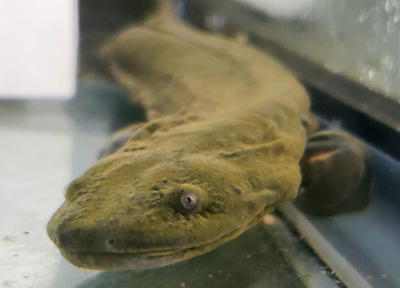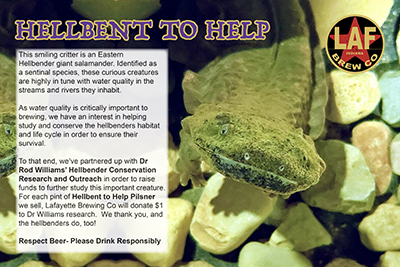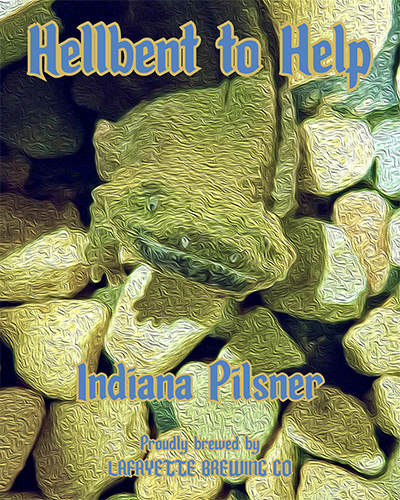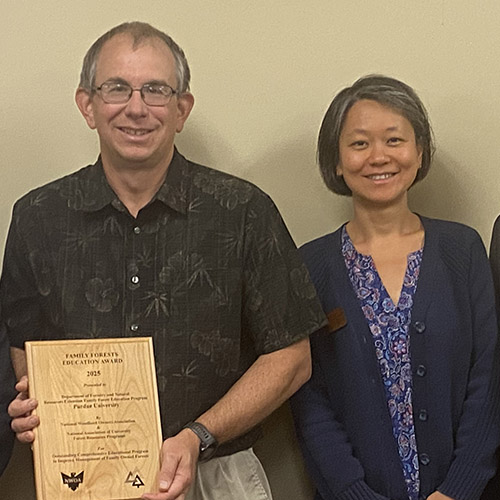Local Brewery Creates Beer to Help the Hellbender
 For much of the last 15 years, Dr. Rod Williams and his team have been researching eastern hellbenders, spearheading regional conservation efforts and advancing hellbender captive propagation, or the rearing of this ancient animal in captivity and their eventual return to the wild.
For much of the last 15 years, Dr. Rod Williams and his team have been researching eastern hellbenders, spearheading regional conservation efforts and advancing hellbender captive propagation, or the rearing of this ancient animal in captivity and their eventual return to the wild.
After five years of breeding efforts, Williams’ partners at the Mesker Park Zoo in Evansville, Indiana, successfully bred eastern hellbenders naturally in captivity in October 2020, signifying the culmination of a long and collaborative effort to breed the species and restore this endangered species to its native environment.
Eastern hellbenders, the largest salamanders in North America, breathe through capillaries near the surface of their skin, absorbing oxygen directly from the water. This requires high quality streams and the species has struggled to survive after decades of declining water quality and habitat degradation. Because of these factors, hellbenders are often seen as canaries in the coal mine (or salamanders in the stream as it were) when it comes to water quality.
This unique quality caught the attention of Lafayette Brewing Company owners Greg and Nancy Emig, who have decided to team up with the Williams Lab to raise funds for research, conservation and education.
Shelby Royal, hellbender husbandry coordinator in the Williams lab, explained the origins of the Lafayette Brewing Company fundraiser.
“Greg and Nancy are extremely wonderful people and expressed interest in my research when I started working at LBC in March 2021,” Royal said. “They had never heard of a hellbender and saw my passion for my job and research here at Purdue and that's when my brother (Will Royal, manager at LBC) proposed a fundraiser by brewing a beer specifically to raise money for the hellbenders. They loved the idea and designed the Hellbent to Help Fundraiser! Funds from the Hellbent to Help fundraiser will help to not only provide necessary items like food and shelter rocks, but it will also provide funds for new and improved enclosures for more naturalistic rearing practices!”
The beer’s description states that Hellbent to Help is a German style pilsner. Golden in color with a soft floral aroma, the beer is crisp and clean with a slightly dry finish. The perfect refresher on a hot summer's day!
 Advertisements for the fundraiser also seek to educate patrons about the importance of hellbenders.
Advertisements for the fundraiser also seek to educate patrons about the importance of hellbenders.
“Identified as a sentinel species, these curious creatures are highly in tune with water quality in the streams and rivers they inhabit. As water quality is critically important to brewing, we have an interest in helping study and conserve the hellbenders’ habitat and life cycle in order to ensure their survival.”
Lafayette Brewing Company will donate $1 of each purchase of a pint of its newly brewed Hellbent to Help Pilsner beer to the Williams’ lab hellbender conservation research and outreach efforts in order to provide funds to further study the species. T-shirts featuring the Hellbent to Help logo art will be available for $25 with $5 of each sale going toward research funding.
“It’s important for LBC to get involved in this project for a couple reasons,” Greg Emig said. “First and foremost, we are community focused. LBC has donated well over $100,000 over the years to local not-for-profit organizations and Purdue University, including establishing the Laura Williams Memorial Scholarship in the School of Health and Human Sciences at Purdue in memory of Nancy’s sister, Laura. Secondly, we like to direct funds to projects and organizations that are also important to our staff and guests. Shelby's enthusiasm in the hellbender research opened a door for us to learn more. And finally, the hellbender’s sentinel species status and its innate connection to our waterways sort of completed the package. Obviously, water quality is essential to not just brewing, but all life. Our ability to protect and study these unique creatures will help provide insight into how we’re managing the quality of our water resources.”
 Hellbent to Help is scheduled to be released on Saturday, June 25, and will be available on tap at Lafayette Brewing Company while supplies last. A release party, complete with an appearance by Herbie the Hellbender, the Williams lab's mascot, will take place from 11 a.m. to 1 p.m.
Hellbent to Help is scheduled to be released on Saturday, June 25, and will be available on tap at Lafayette Brewing Company while supplies last. A release party, complete with an appearance by Herbie the Hellbender, the Williams lab's mascot, will take place from 11 a.m. to 1 p.m.
There are two subspecies of Hellbender, the eastern hellbender (Cryptobranchus alleganiensis alleganiensis) and the Ozark hellbender (Cryptobranchus alleganiensis bishopi). The eastern hellbender is a large, fully aquatic salamander, nicknamed the snot otter, water dog, devil dog, Allegheny alligator and water eel among other things. At maturity, the species can measure approximately two feet long.
Characterized by flat bodies and heads, slimy blotchy brown skin with folds along the sides that are often said to resemble lasagna noodles, and long tails, eastern hellbenders live in shallow, fast-flowing, cool, rocky rivers and streams across the United States from New York to Georgia and as far west as Missouri and Arkansas.
The efforts of Williams’ lab and other regional partners were recently featured in a documentary titled Hellbender in the Blue.
Hellbender partners featured in the film include Purdue FNR, Evansville Zoological Society, The Association of Zoos and Aquariums, Clark Waldrum Conservation fund, Pittsburgh Zoo and PPG Aquarium, PPG Conservation and Sustainability Fund, and the AZA Amphibian Taxon Advisory Group's Small Grant Fund.
Williams’ hellbender lab is actively collaborating with the Indiana Department of Natural Resources, Indiana Division of Fish and Wildlife and The Nature Conservancy as well as several other partners across 13 states on a number of conservation projects and educational opportunities for teachers and children and more.
For more information on the eastern hellbender, visit the Help the Hellbender website.
Additional Resources
The Hellbender was highlighted by the Alliance for America’s Fish and Wildlife in its promotion efforts for the Recovering America’s Wildlife Act. https://www.fishwildlife.org/story-map-rawa and https://www.youtube.com/watch?v=XsxKhZvDtYM
Help the Hellbender was also featured on the cover of the January/February 2019 issue of Outdoor Indiana.
Learn about hellbenders and take a tour of Purdue’s hellbender rearing facility: VideoLearn about the hellbender work at Mesker Park Zoo: Video
Learn about hellbender work at The Wilds: Video
View Williams’ 2017 TEDx Talk on hellbenders here: Video
A Moment in the Wild - Hellbender Hides: Video
A Moment in the Wild - Hellbender Release: Video
Nature of Teaching - Hellbenders Rock Sneak Peek: Video
Nature of Teaching - Hellbenders Rock webinar: Video






